Gray Whales Count

We have defined Gray Whales Count as a research and education project, in which observers (Counters) on land monitor the passage of gray whales (Eschrichtius robustus) migrating northbound through the nearshore of the Santa Barbara Channel, along a corridor extending approximately 3 nautical miles (nm) from shore.
The survey is approximately 100 consecutive days from mid-February though most of May. Conditions permitting, each survey-day begins at 9 AM and ends usually at 5 PM.
Goals
The goals of the research are to estimate the number of gray whales and gray-whale calves migrating northbound through our corridor and to share our data to complement similar sampling-studies along the California coast.
Goals of education are to teach the process of scientific research to Counters and to give them the opportunity to conduct a meaningful study, to experience marine mammals in their environment, and to share this process and their enthusiasm with publics through outreach and various media, especially the internet.
SITE
Our survey site is Counter Point on the
Coal Oil Point Reserve in Goleta, California, USA. The coastline runs east-west, with northbound whales traveling west, left to right across our Point towards Point Conception. We are able to track across 200 degrees from 80˚ to 280˚ magnetic. Unfortunately, facing east, south, and west, observers also track the sun across the day.
Counters
The observation team consists of from one to five Counters, including the Project Coordinator, up to two Supervisors, and up to two Observers. Supervisor shifts are four hours; Observer shifts are two hours; and the Project Coordinator is usually on-site all day. The Project Coordinator and/or a Supervisor is always on Counter Point.
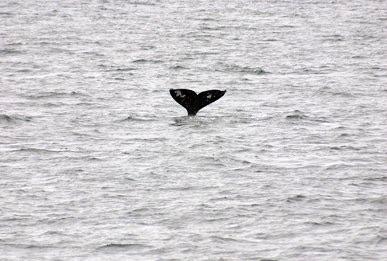
About GWC
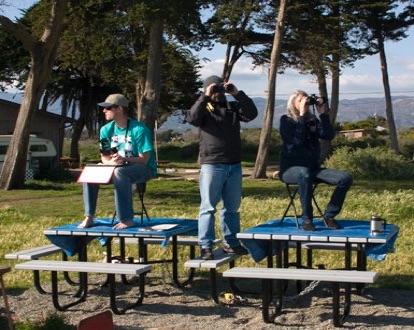
GRAY WHALES COUNT
PROJECT COORDINATOR:
Andrea Dransfield
andrea@graywhalescount.org
805-618-5768
PROJECT COLLABORATORS INCLUDE:
UCSB's Coal Oil Point Reserve, Goleta
NOAA Southwest Fisheries
Science Center
Scripps Whale Acoustic Lab,
SIO/UCSD, La Jolla
Cascadia Research Collective, Olympia, WA
Collaboration
From our inception we have embraced collaboration. We began as a research project of the American Cetacean Society-Channel Islands (ACS-CI) in 2004. Though we are now an independent, nonprofit corporation for research and education, we share with the American Cetacean Society their commitment to and enthusiasm for cetacean well-being.

Operating our survey at the Coal Oil Point Reserve naturally fosters our growing involvement with UCSB, particularly the Marine Science Institute (MSI), which administers the Reserve.
Cascadia Research Collective, with some thirty years of gray whale research and unmatched experience in the Santa Barbara Channel, helped define our scope and continues to counsel our effort, which has led to collaborating with the Scripps Whale Acoustic Lab, monitoring the underwater sounds surrounding our Point.
The Otter Project, US Geologic Survey, US Fish & Wildlife, and California Department of Fish & Wildlife share an interest in otters and have come to rely on Gray Whales Count reporting of otter activity.
Closer to home, mathematics students at California State University, Channel Island, with input from NOAA scientists at Southwest Fisheries, are formulating methods to analyze our raw data.
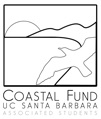
We are immensely grateful for the foundation of support for our work.

An anonymous donor through the The Orange County Community Foundation believes in the effectiveness and quality of our research and education program.
Their support has been — truly —
our foundation.
We have enjoyed some very special collaborations and support from our local community, including our Counters.
Starting in 2011 we received annual grants, initiated by a Counter, from the James Ryerson Environmental Fund, administered by the Santa Barbara Foundation.
Each day on Counter Point we talk many times to the captains of the Condor Express, who generously share what is out there beyond what we can see. The late Fred Benko, who owned the Condor Express, with Jean and her late husband Barry Schuyler, Jr came to our rescue in an emergency, when we had no binoculars.
We are particularly proud of Counter/corporation partnerships in which the employer matches a donation and/or volunteer effort, expanding the donation, creating community investment.
Thank you FLIR Corporation of Goleta and United Launch Alliance of Chicago (which operates at Vandenberg Air Force Base, just up the coast from us).
Special thanks
to Charles Greene and Greeneridge Sciences and to Tony Urwick.
— Thank you all.
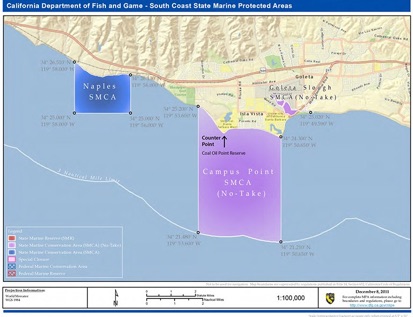
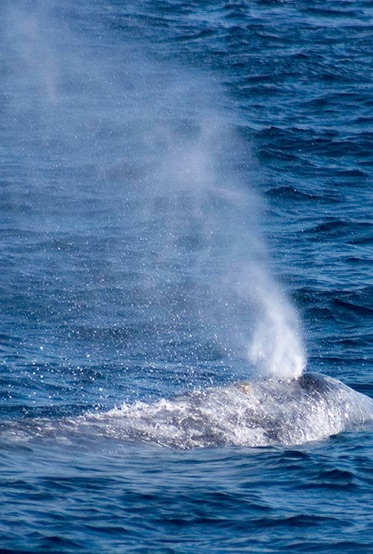
Just before summer of 2012, Gray Whales Count organized a workshop for the community about "Wise use of the nearshore Channel and Marine Protected Areas" at the Bren School of Environmental Science & Management at UCSB, a short walk from the shores of the Santa Barbara Channel .
Our data collected over these past eight surveys is a baseline that will be useful in evaluating the success of the 2012 implementation by the California Department of Fish & Wildlife of Campus Point State Marine Conservation Area (MPA) extending from Campus Point, 2 miles west to Counter Point then a mile and a half further west towards Ellwood.
We are in perfect position for essential and ongoing monitoring during our annual survey..

Andrea Dransfield, Project Coordinator | 805-618-5768 | andrea@graywhalescount.org
© Gray Whales Count, 2020. All rights reserved.